| Revision as of 16:59, 13 June 2023 editDanial Bass (talk | contribs)Extended confirmed users9,596 edits the recent edits are clearly not an improvement: bad writeup/grammar, peacock termsTags: Manual revert Reverted Visual edit← Previous edit | Revision as of 17:06, 13 June 2023 edit undoKunhistory (talk | contribs)31 edits grammar what ? a lot of Cambodia article was fake writing by admin Misplaced Pages.Tags: Undo Reverted Disambiguation links addedNext edit → | ||
| Line 1: | Line 1: | ||
| {{Short description|Prominent Buddhist temple in Phnom Penh, Cambodia}} | {{Short description|Prominent Buddhist temple in Phnom Penh, Cambodia}} | ||
| {{distinguish|Wat Phra That Phanom}} | |||
| {{Infobox religious building | {{Infobox religious building | ||
| | name = Wat Phnom | | name = Wat Phnom | ||
| Line 19: | Line 18: | ||
| }} | }} | ||
| '''Wat Phnom''' or '''Wat Phnom Doun Penh''' ({{lang-km|វត្តភ្នំដូនពេញ}}) or (វត្តភ្នំ) is one of the oldest pagodas in Cambodia, about 650 years old, under construction and renovation by four kings. Wat Phnom is a center of religious, cultural and historical monuments that is the main symbol in the identification of the name of Phnom Penh. This pagoda has a total height of 46 meters equal to the height of 150 feet. The name of Grandma Doun Penh, the founder of this pagoda, was first established in 1372, which is related to the discovery of four statues in a Koki tree near the river bank. These four statues include: | |||
| '''Wat Phnom''' ({{lang-km|វត្តភ្នំ}}, ]: {{transl|km|Vôtt Phnum}}, ]: {{transl|km|Vatt Bhnaṃ}} {{IPA-km|ʋɔət pʰnom|}}; "Mountain Pagoda") is a ] ] (]) in ], ]. It is a ], that symbolizes the name of Phnom Penh, and a historical site that is part of the Khmer national identity. Wat Phnom has a total height of 46 meters (150ft).<ref> {{cite web |url=https://www.peakbagger.com/peak.aspx?pid=30525 |title= Wat Phnom Cambodia |last= |first= |date= |website= Peakbager.com database |publisher= |access-date= 1 November 2004 |quote=}} </ref> The pagoda is named after Lady ] from the story of the discovery of the five statues: four ] and one Vishnu statue. | |||
| * ] statue made of Jade Stone | |||
| * ] statue made of gold | |||
| * ] statue made of Bronze | |||
| * Komchay statue as (]) made of Brass. This fame has made many Chinese merchants and Cambodians of Chinese descent to pray in large numbers like this, and only a preacher named "Preah Dhamma Lanka" to pay homage to him and request this Budai statue from Doun Penh take to keep at "Wat Preah Puth Khosachar" (Buddha Khosachar Pagoda), then the pagoda was renamed as the "Chin Dam Dek pagoda" after many Chinese people who came to live there came to work in the steel rods business area after going through many war eras, the traces of faith have disappeared gradually, as well as the changing times in Cambodia, Cambodians of Chinese descent also have different beliefs about the ancestors to the present day, starting from the prayer of the Budai statue, a sculptural art from China.<ref> Madeline Elizabeth Ehrman, Kem Sos (1972) , Publisher: Foreign Service Institute, Department of State, Original from University of Illinois at Urbana-Champaign p.115 </ref> <ref> Peakbagger (2004) , Website: www.peakbagger.com, Publication: 1 November 2004 </ref> | |||
| ==History== | == History == | ||
| ]]] | ] | ||
| Wat Phnom describes the events of King Ponhea Yat, who raised the capital from Tuol Basan, Kampong Cham province, to the Chaktomuk area (now: ]), the confluence of four rivers: the ], the upper ], and the Lower Mekong. And the ], the confluence of the four rivers, is called the Chaktomuk River. Before King Ponhea Yat arrived in Chaktomuk, Wat Phnom was completed by Doun Penh in 1372 AD, during the reign of King Dhamma Reachea I until the reign of King Ponhea Yat, who Raised the capital from Tuol Basan ] to the ] area during the time when the capital Tuol Basan was inundated by the Great Flood in the year 1397 AD, three years of constructions a new city in the Chaktomuk area. Panhea Yat named this new city call: "Krong Chaktomuk Mongkol Sakal Kampuchea Thipadei Sereythorabovor Indrabat Borei Roth Reach Seima Maha Nokor" commonly known as the Chaktomuk city, was proclaimed in 1400 AD.<ref> Société asiatique (Paris, France) (1871) , Contributor: Centre national de la recherche scientifique (France), Publisher: Société asiatique., Original from National Library of the Netherlands </ref> | |||
| === Ponhea Yat Main Stupa === | |||
| In 1372, a wealthy old lady named "]" lived on a small hill near the bank of the confluence of the four rivers. One day, when it was raining, Penh went down to the port to take a bath and saw a floating Koki tree in the river and she called the village to fish it from the water. She and the villagers took a piece of wood to scrape off the mud and in the hole of the Koki tree, there were four ] statues made of bronze, brass and one made of marble. Another statue was in the form of ] with the hands holding a staff, a chain, a ], and a ]. Penh asked the villagers to help retrieve the Koki tree and retrieve the four treasures. Later, Penh assigned the villagers to build an artificial hill and build a small wooden temple on top of the hill to house the statue. She invited ] to bless the statues and the monks named the hermitage "Wat Phnom" which is known to this day.<ref> {{cite book |author= Cambodia. Krasuaṅ Ghosanākār nẏṅ Vappadharm |date= 1990 |title= Prajum rẏan breṅ Khmaer, Volume 5|url=https://books.google.com/books?id=ITxfsj1iE38C |location= |publisher= Buddha Sāsanapaṇdity, Original from ] |page= |isbn=}} </ref> | |||
| ] | |||
| The Great Ponhea Yat Stupa was built by King Noreay Reamea in 1433 to 1434 AD, after King Ponhea Yat died in 1432 AD. The Great Ponhea Yat Stupa is 27 meters high and was built all year round to house his remains. After the completion of the construction, Preah Noreay Reamea, the eldest son of Ponhea Yat, also conducted a seven-day Buddhist chanting ceremony, buried about 10,000 colorful gems, and issued a proclamation in the name of Wat Phnom to call "Wat Chetdei Boro Poat" until the time of change is also called Wat Phnom until today.<ref> Kaev Bhuan (2004) , Publisher: Ponleu Khmer, Original from the University of California p.295 </ref> Wat Phnom of the reign of King Dhamma Reachea II After the death of Srei Reachea and Srei Soriyoatei at ], Dhamma Reachea II sent envoys to repatriate the remains of both Reams to Cambodia in 1485 AD. He ordered the construction of two more stupas on the grounds of Wat Phnom to house the relics (bones) of his dynasty. He also generously donated royal property to 21 villages, 21 fields famer, 21 males, 21 females, 21 ox carts, 21 buffalo carts, 21 horses, 21 elephants, and various musical instruments to keep as slaves to cleaning of this pagoda including the stupa dynasty. Later, Dhamma Reachea II died in the capital, Tuol Basan ], in 1486 AD, his son "Dhammakhat Sokunthor" intended to bury the remains of his father Dhamma Reachea II at the pagoda of Chaktomuk, but later he changed his mind and decided to bury his father 's remains in Asantuk (now: ]). When he returned from burying his father, he went to visit his younger brother Ponhea Chan also call ] with a royal gift of some elephants, and then proclaimed his reign in Tuol Basan in 1486 AD, The era with the royal name Srei Sokunbot.<ref> Eng Soth, Lim Yan (1969) , Publisher: Member of the Historical Committee Ministry of Education, Youth, and Sport, OCLC Number: 1112074917 </ref> | |||
| === 15th century === | |||
| King ] (also known as Barom Reachea I) was King of Cambodia and reigned at Tuol Basan (]) for nine years. At the time there was severe flooding in that area, during which the capital was flooded deep in 1396 AD. When the water receded that year, He ordered Chao Ponhea Decho, the governor of Samrong Tong Province to build a new palace in Russey Keo village in the area of (Wat Phnom) today. Chao Ponhea Decho ordered the people to dig from an area which is now located where the ] currently stands. The hole created a lake called Boeung Decho. After a year of flooding, King Ponhea Yat moved his court from Tuol Basan, ] to the confluence of the ] River in 1397 AD. After the completion of the palace, King Ponhea Yat ordered the construction of a hermitage hut on the top of the mountain near the temple of Wat Phnom, the hermitage of the district chief, which Cambodians today call ] Preah Chao and Wat Phnom called "Wat Phnom Doun Penh" "Which marks the name of Grandma "Doun Penh ". After completing the construction of his palace and city, he named the city "Chaktomuk Sakal Kampuchea Thibdey Udiya Mohanakor" in 1416 AD. His reign at Chaktomuk begun the "Chaktomuk Period" of the Kingdom of Kampuchea in 1431. After his death, a large ] was built for him at the top of Wat Phnom.<ref>{{cite book |author= Hoc Dy Khing |date= |title= Aperçu général sur la littérature khmère |url= https://www.worldcat.org/oclc/1179208816 |location= |publisher= Paris ; Montréral, Qc : L'Harmattan, 1997. |page= 205 |isbn=|oclc= 1179208816}} {{ISBN|978-27-38451-40-8}}</ref> | |||
| == Wat Phnom in the reign of King Sisowath == | |||
| ] | |||
| The Franco-Khmer Friendship Memorial statue was erected at the waist of Wat Phnom Doun Penh, located to the south next to the giant clock of Wat Phnom. This statue is a bronze statue of King ] In 1909 AD, but later the original statue was taken to the National Museum in Phnom Penh and replaced by a statue of him, which was built in 1998, where his statue is in The attitude of sitting on the throne to receive the representation of the three provinces that Cambodia received from the Franco-Siamese Treaties, which took place on March 15, 1907, after the end of the Franco-Siamese war that erupted. In 1893 AD, during the reign of King ]. To the left of the statue of Sisowath are the three women servants palace, bringing back the three objects placed on the trophy representing the three provinces that Cambodia was to receive from ], including: ], Sisophon (now: ]). And ] Province. The image on the right is a portrait of a Cambodian army in French uniform, accompanied by the French flag, backing the three provinces. The three received from Siam are also back, and at the bottom of the frame is a portrait of the French Governor for Cambodia, "Louis Paul Luce".<ref> George Walter Prothero, Great Britain. Foreign Office. Historical Section (1920) , Publisher: H.M. Stationery Office, Original from the University of California p.77 </ref> <ref> Donald P. Whitaker, American University (Washington, D.C.). Foreign Area Studies (1973) , Publisher: U.S. Government Printing Office, Original from the University of Michigan p.389 </ref> | |||
| == The Legend of Wat Phnom == | |||
| ] | |||
| The story of Wat Phnom Doun Penh, which dates back to 1916 BE and 1372 AD, tells the story of an old woman named "Doun Penh" who lived in abundance near the riverfront, her houses are built on a hill east of a small hill. One day, there was heavy rain, the river was flooded, and Doun Penh went down to the port and suddenly saw a large Koki tree floating around near the bank of the river near her port, Doun Penh looked at the hole in the tree, as if there was something in it, Doun Penh took a small branch to clean the mud and her Found in the hole of Koki tree, there are 4 statues of gods in it. The four statues are made of Jade, gold, bronze and brass. With this joy, Doun Penh called the villagers to come and see them and told them to tie a rope and drag the Koki tree to dig out the four statues. Doun Penh and the villagers were happy to discuss the construction of a hermitage to house the four statues as a place of worship. After the construction of the hermitage, Doun Penh and the villagers Let's march the four statues to be placed on the top of this small mountain. The children of the villagers always tobe monks and came to live in this hermitage. Doun Penh also used her own money to build a vihara to house the four statues. The jade statue stands with four arms, one hand holding a stick and the chakra, the other holding a snail and a lotus flower in the form of a deity as Preah Noreay that mean ], The golden statue of the ] in the form of defeating the devil, The bronze statue of the deity has a unique design in the form of a crown, looklike deva, presumed to be an ], The brass statue is in the form of a fat monk and has a smiling face, presumably tobe Preah Komchay as ] maybe from a distant land of another kingdom. Due to the monks building a shrine on the mountain vihara, the villagers decided to build a pagoda called "Wat Phnom Doun Penh", named after Doun Penh since then.<ref> Khmer Traditional Church of Cambodia Buddhist Academy (1963) , Publisher: Cambodia Buddhist Academy, Original From the University of Michigan, OCLC Number: 23507949 </ref> | |||
| == Religious Variations == | |||
| '''] | |||
| The shrine of Wat Phnom Doun Penh is often visited by many people, especially Cambodians of Chinese descent, who believe in the elders, who are marked as local elders in Spiritualism, and they often bring other offerings. To pray for peace mind and to cut off all unhappiness as well. According to some elders who went through a period of ancestral rites that first began during ] in 1941, ] launched an attack on a ] military base in Cambodia, The Siam Air Force flew several planes to bomb Phnom Penh, frightened people fled to the grounds of Wat Phnom Doun Penh, some bombs fell on the Old Market, Central Market, Wall Royal Palace and fishing boats along the riverbank, but no bomb blast near Wat Phnom, Residents fleeing to hide at Wat Phnom recounted their prayers to the Wat Phnom district chief to help take care of them, while two Siam Air Force planes were shot down by French troops. Believing in the elders Spiritualism of Wat Phnom district, a small hermitage east of Wat Phnom was visited by the people until the village was named "Neak Ta Preah Chao" from that time.<ref> Charles F. Keyes, Laurel Kendall, Helen Hardacre (1994) , Publisher: University of Hawaii Press p.368 ]: 0824814711, 9780824814717 </ref> | |||
| == Cambodia art sculpture decrease == | |||
| ] | |||
| Every time people go to pray at Wat Phnom Doun Penh, they do not skip bringing a bouquet of jasmine or lotus flowers to Doun Penh. A statue of Doun Penh is made during 1990s after the end of Cambodia civil war that erupted for 28 years. The decline of Cambodian art by Cambodia at that time was forgotten by the ] regime led by ]. In this brutal regime, the ] deceived thousands of teachers, professors and students skill from abroad to kill more in 1977 through a video of research activities organized by the Khmer Rouge to propagandize and deceive the intellectuals to return to Cambodia for national development, but in reality, those intellectuals were they took him to be killed. Due to the lack of human resources in Cambodia, Cambodian art sculptures began to decline, some of the sculptures did not meet professional standards.<ref> Raymond A. Zepp (1997) , Publisher: Bert's Books, Original from the University of Michigan p.69 </ref> | |||
| ==Architecture== | ==Architecture== | ||
Revision as of 17:06, 13 June 2023
Prominent Buddhist temple in Phnom Penh, Cambodia| Wat Phnom | |
|---|---|
| វត្តភ្នំ | |
 View of Wat Phnom View of Wat Phnom | |
| Religion | |
| Affiliation | Theravada Buddhism |
| Status | Wat Phnom Historical Park |
| Location | |
| Location | Daun Penh, Phnom Penh |
| Country | Cambodia |
| Geographic coordinates | 11°34′34″N 104°55′23″E / 11.57611°N 104.92306°E / 11.57611; 104.92306 |
| Architecture | |
| Founder | Penh |
| Completed | 1372 |
Wat Phnom or Wat Phnom Doun Penh (Template:Lang-km) or (វត្តភ្នំ) is one of the oldest pagodas in Cambodia, about 650 years old, under construction and renovation by four kings. Wat Phnom is a center of religious, cultural and historical monuments that is the main symbol in the identification of the name of Phnom Penh. This pagoda has a total height of 46 meters equal to the height of 150 feet. The name of Grandma Doun Penh, the founder of this pagoda, was first established in 1372, which is related to the discovery of four statues in a Koki tree near the river bank. These four statues include:
- Vishnu statue made of Jade Stone
- Buddha statue made of gold
- Indra statue made of Bronze
- Komchay statue as (Budai) made of Brass. This fame has made many Chinese merchants and Cambodians of Chinese descent to pray in large numbers like this, and only a preacher named "Preah Dhamma Lanka" to pay homage to him and request this Budai statue from Doun Penh take to keep at "Wat Preah Puth Khosachar" (Buddha Khosachar Pagoda), then the pagoda was renamed as the "Chin Dam Dek pagoda" after many Chinese people who came to live there came to work in the steel rods business area after going through many war eras, the traces of faith have disappeared gradually, as well as the changing times in Cambodia, Cambodians of Chinese descent also have different beliefs about the ancestors to the present day, starting from the prayer of the Budai statue, a sculptural art from China.
History

Wat Phnom describes the events of King Ponhea Yat, who raised the capital from Tuol Basan, Kampong Cham province, to the Chaktomuk area (now: Phnom Penh), the confluence of four rivers: the Tonle Sap, the upper Mekong, and the Lower Mekong. And the Bassac River, the confluence of the four rivers, is called the Chaktomuk River. Before King Ponhea Yat arrived in Chaktomuk, Wat Phnom was completed by Doun Penh in 1372 AD, during the reign of King Dhamma Reachea I until the reign of King Ponhea Yat, who Raised the capital from Tuol Basan Kampong Cham to the Chaktomuk area during the time when the capital Tuol Basan was inundated by the Great Flood in the year 1397 AD, three years of constructions a new city in the Chaktomuk area. Panhea Yat named this new city call: "Krong Chaktomuk Mongkol Sakal Kampuchea Thipadei Sereythorabovor Indrabat Borei Roth Reach Seima Maha Nokor" commonly known as the Chaktomuk city, was proclaimed in 1400 AD.
Ponhea Yat Main Stupa

The Great Ponhea Yat Stupa was built by King Noreay Reamea in 1433 to 1434 AD, after King Ponhea Yat died in 1432 AD. The Great Ponhea Yat Stupa is 27 meters high and was built all year round to house his remains. After the completion of the construction, Preah Noreay Reamea, the eldest son of Ponhea Yat, also conducted a seven-day Buddhist chanting ceremony, buried about 10,000 colorful gems, and issued a proclamation in the name of Wat Phnom to call "Wat Chetdei Boro Poat" until the time of change is also called Wat Phnom until today. Wat Phnom of the reign of King Dhamma Reachea II After the death of Srei Reachea and Srei Soriyoatei at Ayutthaya, Dhamma Reachea II sent envoys to repatriate the remains of both Reams to Cambodia in 1485 AD. He ordered the construction of two more stupas on the grounds of Wat Phnom to house the relics (bones) of his dynasty. He also generously donated royal property to 21 villages, 21 fields famer, 21 males, 21 females, 21 ox carts, 21 buffalo carts, 21 horses, 21 elephants, and various musical instruments to keep as slaves to cleaning of this pagoda including the stupa dynasty. Later, Dhamma Reachea II died in the capital, Tuol Basan Kampong Cham, in 1486 AD, his son "Dhammakhat Sokunthor" intended to bury the remains of his father Dhamma Reachea II at the pagoda of Chaktomuk, but later he changed his mind and decided to bury his father 's remains in Asantuk (now: Kampong Thom). When he returned from burying his father, he went to visit his younger brother Ponhea Chan also call Chan Reachea with a royal gift of some elephants, and then proclaimed his reign in Tuol Basan in 1486 AD, The era with the royal name Srei Sokunbot.
Wat Phnom in the reign of King Sisowath

The Franco-Khmer Friendship Memorial statue was erected at the waist of Wat Phnom Doun Penh, located to the south next to the giant clock of Wat Phnom. This statue is a bronze statue of King Sisowath In 1909 AD, but later the original statue was taken to the National Museum in Phnom Penh and replaced by a statue of him, which was built in 1998, where his statue is in The attitude of sitting on the throne to receive the representation of the three provinces that Cambodia received from the Franco-Siamese Treaties, which took place on March 15, 1907, after the end of the Franco-Siamese war that erupted. In 1893 AD, during the reign of King Norodom. To the left of the statue of Sisowath are the three women servants palace, bringing back the three objects placed on the trophy representing the three provinces that Cambodia was to receive from Siam, including: Siem Reap, Sisophon (now: Banteay Meanchey). And Battambang Province. The image on the right is a portrait of a Cambodian army in French uniform, accompanied by the French flag, backing the three provinces. The three received from Siam are also back, and at the bottom of the frame is a portrait of the French Governor for Cambodia, "Louis Paul Luce".
The Legend of Wat Phnom

The story of Wat Phnom Doun Penh, which dates back to 1916 BE and 1372 AD, tells the story of an old woman named "Doun Penh" who lived in abundance near the riverfront, her houses are built on a hill east of a small hill. One day, there was heavy rain, the river was flooded, and Doun Penh went down to the port and suddenly saw a large Koki tree floating around near the bank of the river near her port, Doun Penh looked at the hole in the tree, as if there was something in it, Doun Penh took a small branch to clean the mud and her Found in the hole of Koki tree, there are 4 statues of gods in it. The four statues are made of Jade, gold, bronze and brass. With this joy, Doun Penh called the villagers to come and see them and told them to tie a rope and drag the Koki tree to dig out the four statues. Doun Penh and the villagers were happy to discuss the construction of a hermitage to house the four statues as a place of worship. After the construction of the hermitage, Doun Penh and the villagers Let's march the four statues to be placed on the top of this small mountain. The children of the villagers always tobe monks and came to live in this hermitage. Doun Penh also used her own money to build a vihara to house the four statues. The jade statue stands with four arms, one hand holding a stick and the chakra, the other holding a snail and a lotus flower in the form of a deity as Preah Noreay that mean Vishnu, The golden statue of the Buddha in the form of defeating the devil, The bronze statue of the deity has a unique design in the form of a crown, looklike deva, presumed to be an Indra, The brass statue is in the form of a fat monk and has a smiling face, presumably tobe Preah Komchay as Budai maybe from a distant land of another kingdom. Due to the monks building a shrine on the mountain vihara, the villagers decided to build a pagoda called "Wat Phnom Doun Penh", named after Doun Penh since then.
Religious Variations

The shrine of Wat Phnom Doun Penh is often visited by many people, especially Cambodians of Chinese descent, who believe in the elders, who are marked as local elders in Spiritualism, and they often bring other offerings. To pray for peace mind and to cut off all unhappiness as well. According to some elders who went through a period of ancestral rites that first began during World War II in 1941, Siam launched an attack on a French military base in Cambodia, The Siam Air Force flew several planes to bomb Phnom Penh, frightened people fled to the grounds of Wat Phnom Doun Penh, some bombs fell on the Old Market, Central Market, Wall Royal Palace and fishing boats along the riverbank, but no bomb blast near Wat Phnom, Residents fleeing to hide at Wat Phnom recounted their prayers to the Wat Phnom district chief to help take care of them, while two Siam Air Force planes were shot down by French troops. Believing in the elders Spiritualism of Wat Phnom district, a small hermitage east of Wat Phnom was visited by the people until the village was named "Neak Ta Preah Chao" from that time.
Cambodia art sculpture decrease

Every time people go to pray at Wat Phnom Doun Penh, they do not skip bringing a bouquet of jasmine or lotus flowers to Doun Penh. A statue of Doun Penh is made during 1990s after the end of Cambodia civil war that erupted for 28 years. The decline of Cambodian art by Cambodia at that time was forgotten by the Democratic Kampuchea regime led by Pol Pot. In this brutal regime, the Khmer Rouge deceived thousands of teachers, professors and students skill from abroad to kill more in 1977 through a video of research activities organized by the Khmer Rouge to propagandize and deceive the intellectuals to return to Cambodia for national development, but in reality, those intellectuals were they took him to be killed. Due to the lack of human resources in Cambodia, Cambodian art sculptures began to decline, some of the sculptures did not meet professional standards.
Architecture

The sanctuary itself was rebuilt several times in the 19th century and again in 1926. The interior has a central altar complex with a large bronze seated Buddha surrounded by other statues, flowers, candles and items of devotion and worship. The walls are covered with murals, especially of Jataka stories of the Buddha's earlier reincarnations before his attainment of Enlightenment. There are also murals depicting stories from the Reamker, the Khmer version of the Ramayana. The newer murals in the bottom tiers are somewhat balanced, traditional and modern.
The southwest corner of the temple and stupa, is a small shrine dedicated to Lady Penh. The front is often crowded with the faithful bringing their prayers and food offerings to the woman deemed responsible for the founding of the wat.
-
Ponhea Yat Stupa
-
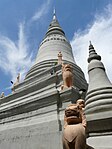 The main stupa on Wat Phnom
The main stupa on Wat Phnom
-
 Main pagoda
Main pagoda
-
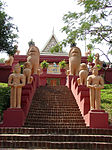 Main stairway leading to the Pagoda
Main stairway leading to the Pagoda
-
 Statue of King Sisowath
Statue of King Sisowath
-
Paintings inside the temple
-
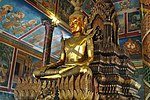 Buddhist shrine inside the pagoda
Buddhist shrine inside the pagoda
-
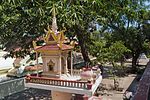 Spirit house
Spirit house
-
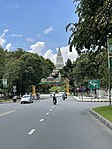 Wat Phnom View from Preah Norodom Blvd
Wat Phnom View from Preah Norodom Blvd
-
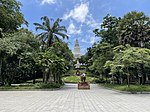 Wat Phnom
Wat Phnom
Cultural references
Wat Phnom appeared on the Travel Channel documentary, 1,000 Places to See Before You Die. It also served as the Pit Stop for the fourth leg of The Amazing Race 15.
See also
References
- Madeline Elizabeth Ehrman, Kem Sos (1972) Contemporary Cambodian: Grammatical Sketch, Publisher: Foreign Service Institute, Department of State, Original from University of Illinois at Urbana-Champaign p.115
- Peakbagger (2004) Wat Phnom, Cambodia, Website: www.peakbagger.com, Publication: 1 November 2004
- Société asiatique (Paris, France) (1871) Journal asiatique, Contributor: Centre national de la recherche scientifique (France), Publisher: Société asiatique., Original from National Library of the Netherlands
- Kaev Bhuan (2004) Tourism Sites of Cambodia, Publisher: Ponleu Khmer, Original from the University of California p.295
- Eng Soth, Lim Yan (1969) Document of the great Khmer man (Khmer royal genealogy), Publisher: Member of the Historical Committee Ministry of Education, Youth, and Sport, OCLC Number: 1112074917
- George Walter Prothero, Great Britain. Foreign Office. Historical Section (1920) Peace Handbooks: Persian Gulf : French and Portuguese possessions, no. 76-81, Publisher: H.M. Stationery Office, Original from the University of California p.77
- Donald P. Whitaker, American University (Washington, D.C.). Foreign Area Studies (1973) Area Handbook for the Khmer Republic (Cambodia), Publisher: U.S. Government Printing Office, Original from the University of Michigan p.389
- Khmer Traditional Church of Cambodia Buddhist Academy (1963) Collection of Khmer legends Volume 5, Publisher: Cambodia Buddhist Academy, Original From the University of Michigan, OCLC Number: 23507949
- Charles F. Keyes, Laurel Kendall, Helen Hardacre (1994) Asian Visions of Authority: Religion and the Modern States of East and Southeast Asia, Publisher: University of Hawaii Press p.368 ISBN: 0824814711, 9780824814717
- Raymond A. Zepp (1997) A Field Guide to Cambodian Pagodas, Publisher: Bert's Books, Original from the University of Michigan p.69
- "'Amazing Race': Episode 3 recap". Digital Spy. December 10, 2009. Retrieved December 31, 2019.
External links
- 360° aerial panorama of Wat Phnom
- [REDACTED] Media related to Wat Phnom at Wikimedia Commons
| Phnom Penh Bus Rapid Transit stations | |
|---|---|
| Line 01 |
|
| Line 02 |
|
| Line 03 |
|
| Line 4A |
|
| Line 4B |
|
| Line 05 |
|
| Line 06 |
|
| Line 7A |
|
| Line 7B |
|
| Line 08 |
|
| Line 09 |
|
| Buddhism in Cambodia | ||||||||
|---|---|---|---|---|---|---|---|---|
| Temples |
|  | ||||||
| Architecture |
| |||||||
| Notable Buddhists | ||||||||
| Notable figures |
| |||||||
| Education | ||||||||
| Culture | ||||||||
| Politics | ||||||||